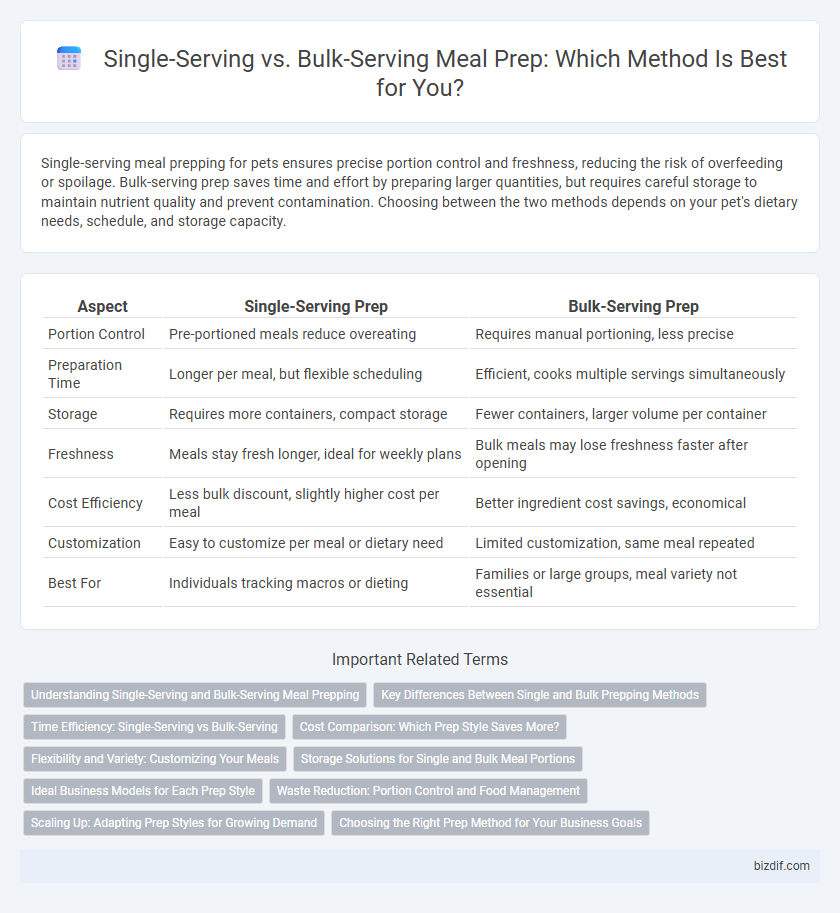Single-serving meal prepping for pets ensures precise portion control and freshness, reducing the risk of overfeeding or spoilage. Bulk-serving prep saves time and effort by preparing larger quantities, but requires careful storage to maintain nutrient quality and prevent contamination. Choosing between the two methods depends on your pet's dietary needs, schedule, and storage capacity.
Table of Comparison
| Aspect | Single-Serving Prep | Bulk-Serving Prep |
|---|---|---|
| Portion Control | Pre-portioned meals reduce overeating | Requires manual portioning, less precise |
| Preparation Time | Longer per meal, but flexible scheduling | Efficient, cooks multiple servings simultaneously |
| Storage | Requires more containers, compact storage | Fewer containers, larger volume per container |
| Freshness | Meals stay fresh longer, ideal for weekly plans | Bulk meals may lose freshness faster after opening |
| Cost Efficiency | Less bulk discount, slightly higher cost per meal | Better ingredient cost savings, economical |
| Customization | Easy to customize per meal or dietary need | Limited customization, same meal repeated |
| Best For | Individuals tracking macros or dieting | Families or large groups, meal variety not essential |
Understanding Single-Serving and Bulk-Serving Meal Prepping
Single-serving meal prepping involves preparing individual portions tailored to specific meals, offering convenience and precise calorie control ideal for weight management or dietary restrictions. Bulk-serving meal prepping focuses on cooking large quantities of a single dish, which saves time and reduces cooking frequency while allowing easy portioning throughout the week. Understanding these methods enables meal planners to optimize freshness, variety, and nutrient retention based on their lifestyle and storage capacity.
Key Differences Between Single and Bulk Prepping Methods
Single-serving meal prepping offers precise portion control, reducing food waste and ensuring freshness by storing meals individually. Bulk-serving prep maximizes cooking efficiency, saving time by preparing large quantities that can be portioned later, ideal for families or batch cooking enthusiasts. Nutritional tracking is easier with single servings, while bulk prep excels in convenience and cost-effectiveness through bulk ingredient purchasing.
Time Efficiency: Single-Serving vs Bulk-Serving
Single-serving meal prepping offers precise portion control but requires more time for individual packaging, which can extend total prep duration. Bulk-serving prep significantly reduces overall preparation time by cooking large quantities at once, allowing quick distribution into meals throughout the week. Choosing between single-serving and bulk-serving depends on balancing time efficiency with convenience and dietary needs.
Cost Comparison: Which Prep Style Saves More?
Single-serving meal prep tends to have higher packaging costs and increased time investment per portion, making it less cost-efficient for large quantities. Bulk-serving prep reduces packaging expenses and optimizes ingredient usage by cooking in larger batches, resulting in significant savings on both money and time. For cost-conscious meal planners, bulk-serving prep is generally the more economical choice due to minimized waste and bulk purchasing discounts.
Flexibility and Variety: Customizing Your Meals
Single-serving meal prepping offers unparalleled flexibility, allowing individuals to customize portion sizes and ingredients according to personal preferences and dietary needs, promoting balanced nutrition. Bulk-serving prep optimizes time efficiency by cooking larger quantities but may limit meal variety and increase meal monotony over time. Choosing single-serving options enhances meal customization, enabling users to experiment with diverse flavors and ingredients for varied, enjoyable eating experiences.
Storage Solutions for Single and Bulk Meal Portions
Single-serving meal prep utilizes portion-controlled containers such as BPA-free plastic, glass jars, or silicone trays that optimize fridge space and maintain freshness for up to five days. Bulk-serving prep benefits from large airtight containers, vacuum-sealed bags, or stackable food bins designed to extend shelf life for up to two weeks when refrigerated or frozen. Incorporating labeled containers with date markers enhances organization and food safety for both single and bulk meal storage solutions.
Ideal Business Models for Each Prep Style
Single-serving prep suits meal delivery services and subscription boxes by offering personalized, portion-controlled meals that cater to individual dietary preferences, enhancing customer satisfaction and retention. Bulk-serving prep aligns well with catering businesses and family meal providers, optimizing kitchen efficiency and reducing packaging costs while meeting the demand for larger quantities. Choosing the right prep style impacts operational scalability, inventory management, and target market engagement strategies in the meal prepping industry.
Waste Reduction: Portion Control and Food Management
Single-serving meal prepping enhances portion control by allowing precise ingredient measurements, which significantly reduces food waste compared to bulk-serving prep. Bulk-serving prep often leads to overproduction and leftover portions that may spoil, whereas individual portions help manage food consumption more efficiently. Effective food management through single-serving prep minimizes waste and promotes better use of ingredients.
Scaling Up: Adapting Prep Styles for Growing Demand
Single-serving prep enables precise portion control and minimizes food waste, making it ideal for individualized dietary needs, while bulk-serving prep excels in efficiency by producing large quantities quickly, suitable for families or meal-sharing. Scaling up meal prep requires balancing these methods to meet increasing demand without sacrificing nutritional balance or freshness. Incorporating modular containers and batch cooking techniques supports adapting single-serving strategies within bulk preparation workflows, optimizing both convenience and scalability.
Choosing the Right Prep Method for Your Business Goals
Single-serving prep offers precise portion control, ideal for customizable menus and minimizing food waste, while bulk-serving prep maximizes efficiency and reduces cooking time, suited for high-volume operations. Assessing your business goals, such as customer preferences, storage capacity, and labor resources, helps determine the optimal method to balance quality and profitability. Analyzing sales data and peak service hours further guides whether individualized or bulk portions better support operational scalability and cost management.
Single-serving prep vs bulk-serving prep Infographic

 bizdif.com
bizdif.com